#1/8/19
Text
Hey chat !!!! I'm going insane.
Ever since my first listen to TMA, I've had a huge question that NEVER got answered.
Never. Not in the whole series, not Q&As or the wiki or anything. I thought I would never find answers. I thought it would be forgotten. I thought it was a small insignificant detail and I'd have to live with never knowing the truth about it.
Now with TMAGP 19, I might finally know the answer.
Maybe. Maybe maybe. But It Could Be. And now I'm losing my mind at the implications.
((For the record, I know that the stories and worldbuilding are inherently separate - hell, there are even timeline differences in the cases I'm using as evidence. But the overlap might be important, especially when it comes to the Web.))
Spoilers for both shows below!
Its branches were exquisite, and delicate, swaying slightly from small eddies in the liquid, and they shone with every spectra. I must confess that to look upon it, one was – (sigh) filled with profound wonder at its exquisite elegance. [...]
Even I, steeped in worldly matters as I am, recognized The Lord’s words to Adam, and was much dismayed at the implication. Isaac then plucked the delicate fruit with ungloved hands and held it before me. [...]
The creature was taking root.
Strands of its mottled brown hair were extruding downwards between the floor, seeking the dark earth below. Then, too, its back began to sprout, radiant branches unfurling and thickening before me, reaching upwards towards the sunlight with a seemingly insatiable desire. [...] I tell you here, Robert, it saw me, and it knew me. (TMAGP 19 - HARD RESET)
It was an ornate wooden thing, with a snaking pattern of lines weaving their way around towards the centre. The pattern was hypnotic and shifted as I watched it, like an optical illusion. I found my eyes following the lines towards the middle of the table, where there was nothing but a small square hole. Graham noticed me staring, and told me that interesting antique furniture was one of his few true passions. Apparently he’d found the table in a second-hand shop during his student days and fallen in love with it. It had been in pretty bad shape but he’d spent a long time and a lot of money restoring it, though he’d never been able to figure out what was supposed to go in the centre. He assumed it was a separate piece and couldn’t track it down. (MAG 3 - ACROSS THE STREET)
Re: Magnus Institute Ruins. By RedCanary on Saturday April 23 2022 12:17pm. The photos from the spelunk seem properly gone, but I did find an old wooden thing with a bunch of similar symbols on. Some kinda empty box, not really sure what for, though. Gonna see if I can get the light right for a decent pic.
Edit: No dice, I’m afraid. Must be something up with my phone camera. Really not helping the whole paranoia thing either. Anyone know anything about photographic distortion? Gonna see if I can borrow my dad’s SLR tomorrow. (TMAGP 1 - FIRST SHIFT)
Adelard Dekker stood in the corner. He was straight and motionless, his lips moving rapidly, though no sound came out of them. In the centre of the room, stood a table carved from dark wood and wrapped all over with a sprawling, intricate pattern. And in front of that table was the thing that had said it was my cousin. It was long and thin, the tops of it bent against the ceiling and its stick-like limbs flailed from too many joints and elbows. Wrapped around it were thick strands of what I think was spider’s web, stretching back into the table, which I now saw pulsed along its carved channels with a sickly light. The face at the top of that gangly frame was like nothing on earth. (MAG 78 - DISTANT COUSIN)
Now... Now I get it. I get it. I finally gave an answer. Or, at least, I think we'll get a concrete answer soon. But I think I get it.
I think I get where the web table comes from. I think I know what it's made of. why it glows. why it had a hole in the middle. I think I might know how the web gained control and sentience so much faster than the other fears. and, if it still manifests in the same way in the Protocol universe, how it also quickly became "the manager" of other fears, as theories suggest.
More importantly, I think I know what was up with the mysterious tree from so, so long ago.
Now I have an answer.
Why was there an apple buried in Hill Top Road?
I opened the box and sitting inside was a single green apple. It looked fresh, shiny, with a coat of condensation like it had just been picked on a cool spring morning. I picked it up. I wasn’t going to eat it, I’m not that stupid, but more than bleeding trees or phantom burning, this confused me.
As I took it out of the box, though, it began to turn. The skin turned brown and bruised and started to shrivel in my hand. Then it split. And out came spiders. Dozens, hundreds of spiders erupting from this apple that was rotting right before my eyes. I shrieked and dropped it before any of them could touch my arm. The apple fell to the ground and burst in a cloud of dust. I backed away and waited until I was sure all the spiders had left before retrieving the box. I smashed it with a crowbar, and threw the remains into a skip. (MAG 8 - BURNED OUT)
And now I have an answer. Maybe.
#ananapost#the magnus protocol#tmagp#the magnus pod#tma#the magnus archives#tmagp theory#tma theory#the web#tma spoilers#Tmagp spoilers#tma the web#hill top road#magpod#the magnus podcast#mag 8#mag 78#mag 3#tmagp 1#tmagp ep 1#tmagp 19#tmagp ep 19#the magnus protocol spoilers#magnus protocol#mag 003#mag 078#mag 008
380 notes
·
View notes
Text
a sneaky list of full poto movies! ;)
youtube
1925
1937 song at midnight
1983
1987 animated
1989 mall
1990
1991 staller
1993 y/k
1995 wishbone
1996 ivan jacobs
2000 ken hill audio
2013 ken hill
2021 korean y/k
leroux audiobook
(these last two are privated every so often, so they're not always available)
musical
lnd
ok.ru
musical
lnd
1943
1962
1974 paradise
1989 freddy
1998 rat phantom
2004
dailymotion
1925 in hd
1995 phantom lover
2011 y/k takarazuka
night gallery
internet archive
musical
1925 original
1974 paradise
1974 hollywood
1983
2004
2004 takarazuka
#i go back to the lnd one every once in a while so i figured i'd put it here for safekeeping! ;)#there are so many other versions on ok.ru! :o#the '25 one has a billion copies on youtube so each number of the year leads to a different video!#same with the mini series ('19' is part 1 and '90' is part 2)#and some of them have backups on other websites! ;)#edit: i added more versions... and colors to make it easier to pick out the parts! ;)#edit boogaloo: third time's a charm since this blew up after adding the private ones! ;D#it only took 8 months for people to find the treasure! :)#now everyone can bask in the goodies!#...and the smol typo
674 notes
·
View notes
Note
Hello! May I please request TBD on this fine Wednesday?
5-8-24 WIP Wednesday (Open) | TBD
Josten declines the call.
He declines the 2nd one as well.
The press conference ends quickly after that with some statements that the Wolves are happy to welcome another wolf into the pack. That they're not concerned about Andrew's lone wolf tendencies in the slightest and that Exy is a violent sport.
It ends about an hour earlier than they had scheduled it for and Josten is out of sight before Andrew can catch him.
<<Prev | First | Next >>
#TBD AU#AFTG#AFTG AU#Andreil#Neil Josten#Andrew Minyard#TBD - Chapter 1 - 23#5-8-24 WIP Wednesday#WIP Wednesday Ask Game#19
43 notes
·
View notes
Text

A Date to Remember <3
#nyanaknifeart#art#illustrations#welcome home#welcome home puppet show#welcome home arg#welcome home fanart#23 8 1 20 4 15 5 19 5 22 5 18 25 20 8 9 14 7 13 5 1 14 20 8 9 19 12 15 15 11#19 15 6 6 9 6 25 15 21 18 5 19 5 5 9 14 7 20 8 9 19 7 15 15 4 12 21 3 11 6 9 14 4 9 14 7 1 12 12 15 6 9 20
384 notes
·
View notes
Text

#Sociale Populaire Nationale#1973#torn posters mounted on canvas#50 х 36 ст.; 19 3/4 × 14 1/8 in. 57.5 × 43.5 cm.; 22 5/8 x 17 1/8 (framed)#Raymond hains
30 notes
·
View notes
Text

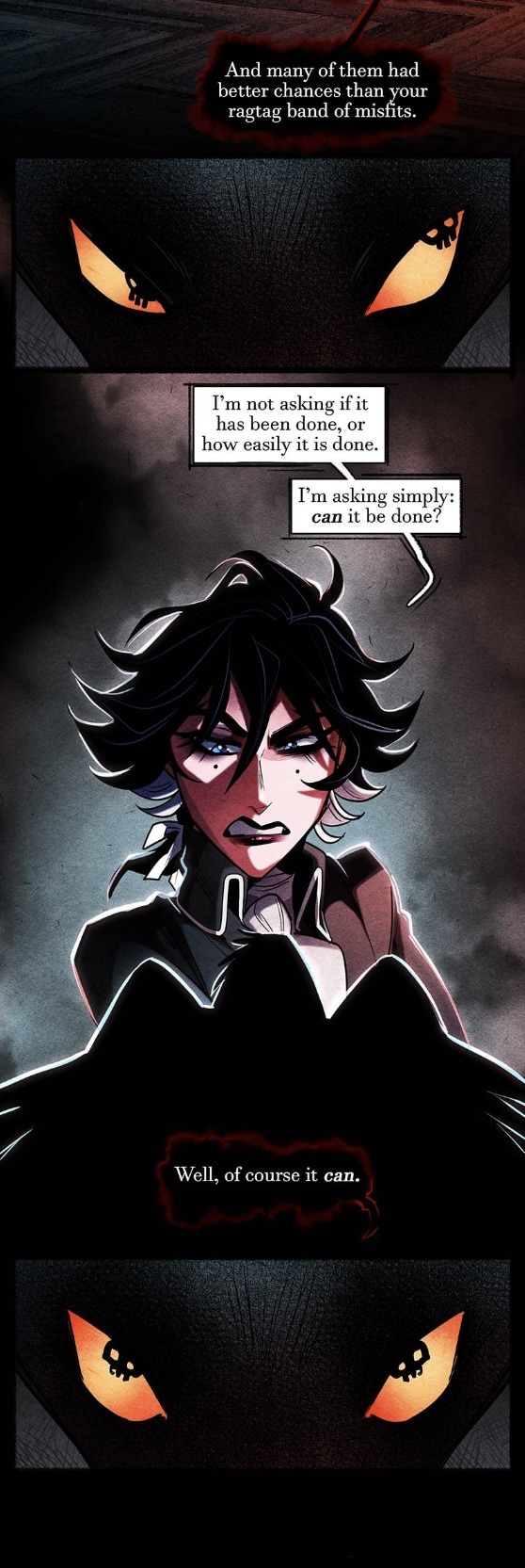




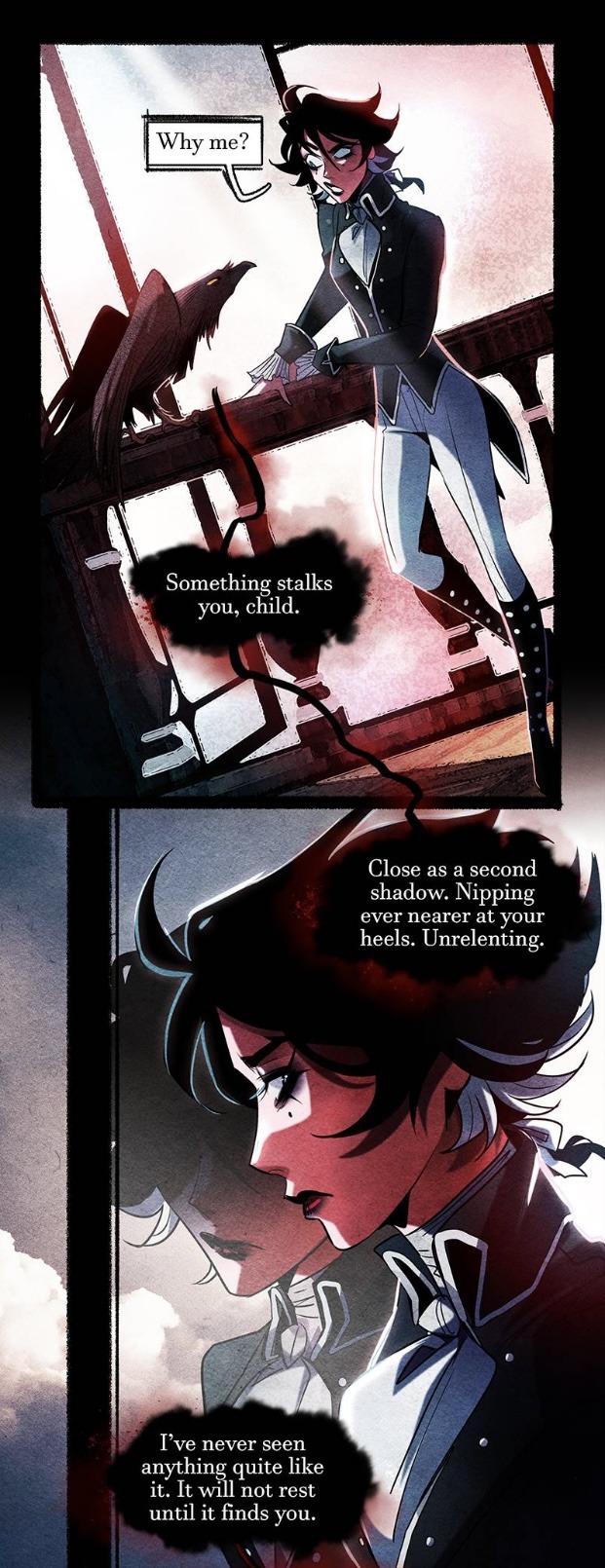



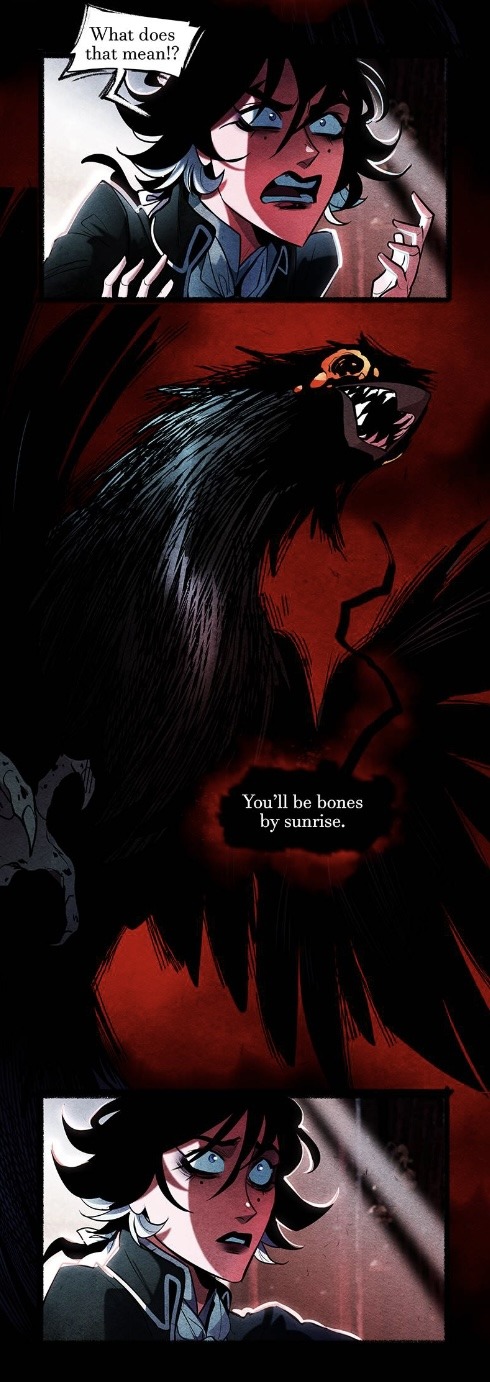

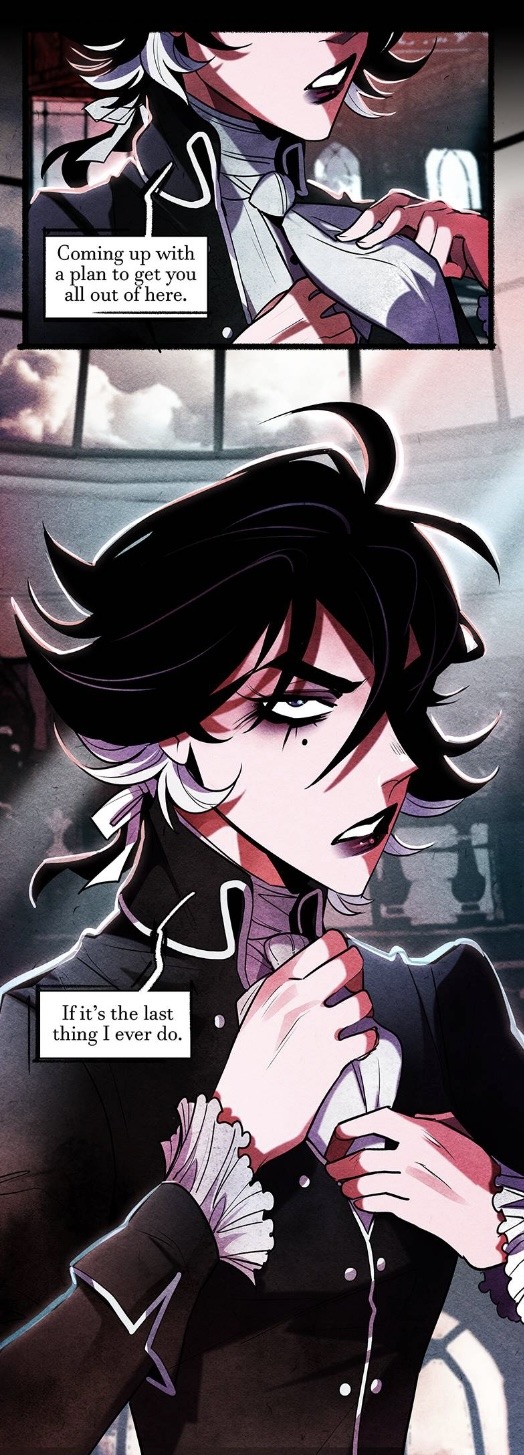
100
#Nevermore#Nevermore Webtoon#Webtoon#OH HELLO I CAN’T BELIEVE WE MADE IT HERE IT’S SO CRAZYYYYYY#3/3/22 - 4/11/24 HAS BEAUTIFUL EPISODES LIKE 1 8 19-29 35 38 41-64 66-69 71-78 84 87 90 97 BUT THEY’RE ALL AMAZING AND RNF DO AMAZING WORK#THANK YOU TWO SO DANG MUCH I LOVE BOTH OF YOUR STORIES#ANYWAY ONTO THE EPISODE LENORE RIGGING THE QUESTION DEAL LOOK AT HERRRRRRR#IT CAN BE DONE?!?!?!?!?? LET’S DO IT#I LOVE THE ABSTRACT DEAN PANELS VERY CUTE#NO WEAKNESSES WHATTTTTTTT. MAYBE LENORE WILL BE THEIR FIRST WHEN SHE MANIFESTS AND DESTROYS THEM#ARE THE DEANS JUST MORE SPIRITS?!?!??? I WONDER#ACADEMY HISTORY?!???!???!! VERY INTERESTING#I FORGOT ABOUT THE CURSE CRAZY IT ACTUALLY COMES INTO PLAY WOWWWWW#RAVEN’S SASSY EXPRESSION— OOP LENORE SNATCHED HIM#AAAAAAAAAAAAAAA HIS DEMON FORM IS SCARYYYYYYY#LENORE SHOUTING AT HIM YES I LOVE VOICING LENORE SHOUTING#DON'T MAKE ME BONEESSSSSSSSSSSSSS#SO MENACINGGGGGGGG#EVERYONE SAW OMG#NO MORE SECRECY AND WE ONLY HAVE LIKE A DAY TO DO IT LET'S GOOOOOOO#AMAZING STORY#THANK YOU RED N FLYNN YOU GUYS ARE OUR AMAZING GOTH WINE AUNTS AND WE LOVE YOU
30 notes
·
View notes
Note
Does the Pines family threaten you?

UGH ALL THE TIME!! I DON'T EVEN HAVE TO DO BE DOING ANYTHING AND ITS "DON'T TOUCH THAT OR I'LL ASSEMBLE A NEW QUANTUM DESTABILIZER" "LET ME MODEL MY DOLL CLOTHES ON YOU" "IF YOU KEEP TRYING TO SET THE SHACK ON FIRE I'LL THROW YOU IN THE OVEN" "IF YOU TRY ANYTHING I'LL FEED YOU TO THE GNOMES"
SO OVER DRAMATIC...

AS IF I'VE DONE ANYTHING WRONG TO DESERVE THEIR CRUELTY!!!
9-22-5 4-15-14-5 14-15-20-8-9-14-7 23-18-15-14-7 9-14 13-25 12-9-6-5 5-22-5-18
#triangulum entangulum#visuals#bill cipher#gravity falls#bill cipher gravity falls#hollowchaoscrescent#ask blog#8-5-19 9-14 4-5-14-9-1-12
16 notes
·
View notes
Text
sometimes its so crazy to realize that there's actually a lot of things i like. that i thought i didn't like because i was a depressed teenager. i love being outside! i love swimming! i love talking to people! even strangers sometimes! i love getting dressed in fun outfits and doing makeup! i love reading and going to art museums! i just thought i was doomed forever to a life of complete and total apathy and void! and now look at me! still a little shaky but i'm doing it!!!!!
#reaching back thru the spacetime continuum to grab 15 year old bunny and shake him by the shoulders a little bit and go hey!!!#it's not ALWAYS gonna be like this!!!#one day you're gonna be 23 and it'll still be like this sometimes!!!#sometimes you'll still wake up and feel it but it won't be all the time!!!!!!#you're gonna have friends who know you and see you even the ugly parts of you#and they're still gonna love you anyways!!!!! it's not over yet i promise!!!!!!#and then one day when i'm 34 i'm sure i'll think the same thing about me now#but until then! it's me and myself when i was 22 and 21 and 20 and 19 and 18 and 17 and 16 and 15#and 14 and 13 and 12 and 11 and 10 and 9 and 8 and 7 and 6 and 5 and 4 and 3 and 2 and 1
13 notes
·
View notes
Text
very early performance of i never told you what i do for a living, october 8th 2003 at the boardwalk in orangevale ca
#i have been to 1 show here. 🫡#i also have to say that october 8 is when i saw them. 19 years later in the same city#fate#my chemical romance
237 notes
·
View notes
Text
Alright I have a lot of ocs for Percy Jackson, but I don’t have a lot of powers for them. Like, the most interesting power I have rn is an Apollo kid who can inflict plague and sickness on other people. All my other characters? Lame! So, give me suggestions on powers for any cabin that aren’t just “Oh, a son of Poseidon controls water”.
Thanks :)
#percy jackson#percy jackon and the olympians#cabins#cabin 1#cabin 2#cabin 3#cabin 4#cabin 5#cabin 6#cabin 7#cabin 8#cabin 9#cabin 10#cabin 11#cabin 12#cabin 13#cabin 14#cabin 15#cabin 16#cabin 17#cabin 18#cabin 19#cabin 20#demigods#power#magic
14 notes
·
View notes
Text
you ever think about how pretty much the only reason we use base10 is because we have 10 fingers and if everyone had 6 fingers on each hand we'd use base12 and never even think a thing of it and also math would be pretty much better in every way?
#i think for this september's existential crisis i'm gonna become a base12 truther#and bc i know everyone on this website is math illiterate so to clarify:#the way base12 works is that we have a few extra digits between 9 and 10#so to count we go:#0 1 2 3 4 5 6 7 8 9 X Y#so X = 10 and Y = 11#then '10' = 12#so the next step of counting goes:#10 11 12 13 14 15 16 17 18 19 1X 1Y#(i know this looks insane to you but the only reason for that is because you are used to base 10 i promise this makes sense#if you throw away everything you know and come at it with fresh eyes)#so anyways in this case '11' = 13. '19' = 21. 1X = 22. 1Y = 23#and '20' = 24#bc the tens column is not the tens column it's actually the twelves column#so each [number] in the second column does not mean 'add [this many] 10s to this' it means 'add [this many] 12s to this'#and this would not be tricky at higher numbers bc in base12 twelve is not counted as 'ten and two' it's just its own thing#in fact it would be harder to multiply by tens bc 10 would be the equivalent of like. 8 here.#it's not its own thing (ten) it's actually 'twelve minus two'#to count by tens goes '0 Y 18 26 34 42 50' and '50' is of course 10x6 in this case so it equals 60 in base10#not hard#there's a pattern to it.#but it's not as easy as counting by 12s#anyways we already have base12 systems and i like them they are very easy to divide#it's only harder than base10 bc arabic numerals are base10 so it's harder to depict base12 logically in a base10 system#hours are base 12. inches to feet are base 12#anyways this post is legally classified as scifi and/or speculative fiction#or. fuck. it's not even fictional#this is how math would work in a different system#sci-nonfi#speculative nonfiction
7 notes
·
View notes
Text


2298
#fallout 4#nora#digital#nora starts raising bees headcanon#they are of course the size of rats now.#everybody needs a hobby right?#i didn't do enough research on beekeeping until after i had already edited in the xl super jumbo beehive. . . . . oops#largest langstroth 10 frame hive box are 19 7/8” long and 16 1/4” wide by 9” deep#which can easily weigh 90 lb when full#this bitch is like three feet wide#so i don't even know#hundreds of pounds per box?#on top of being ten feet tall#lmfaoooo#it’s wildly impractical. but im not making any changes. i think it's extremely funny.
10 notes
·
View notes
Note
TBD please! - @neilimfinejosten
5-8-24 WIP Wednesday (Open) | TBD
The Captains and Coaches get some attention as well as the reporters realize that Andrew is not going to give them the blurb that they can replay over and over again. The Coaches and Captains for the most part all have something nice and bland to say about how excited they are to pay Andrew millions to stand in front of a goal.
"Neil, are you excited to be playing with your old teammate again?"
"Andrew's always been a great Goalie. Having him at my back on Court will be good." Josten answers.
"Yes, Andrew certainly has had your back on the court before. He broke Riko Moriyama's arm your freshman year, are the Wolves worried about his violent streak?" Another reporter who Andrew had brushed off earlier asks.
<<Prev | First | Next >>
#Of course#TBD AU#AFTG#AFTG AU#Andreil#Neil Josten#Andrew Minyard#TBD - Chapter 1 - 19#5-8-24 WIP Wednesday#WIP Wednesday Ask Game#09
41 notes
·
View notes
Text
ever since I was little I never gave a fuck if anyone else liked me, I just wanted to like me and eventually I did for a little while but then I forgot how
#2012 and 2016 were my 2 best years probably#12/13 & 16/17 yro me slayed too hard I fear#1/2/3/4/5/6/7/8/9/10/11/14/15/18/19/20/21/22/23/24/25 flopped#though 20 was ok ily lockdown
12 notes
·
View notes
Text
Cancelled Missions: NASA's October 1977 Space Shuttle Flight Itinerary
"Soon after President Richard Nixon gave his blessing to the Space Shuttle Program on January 5, 1972, NASA scheduled its first orbital flight for 1977, then for March 1978. By early 1975, the date had slipped to March 1979. Funding shortfalls were to blame, as were the daunting engineering challenges of developing the world's first reusable orbital spaceship based on 1970s technology. The schedule slip was actually worse than NASA let on: as early as January 32, 1975, an internal NASA document (marked 'sensitive') gave a '90% probability date' for the first Shuttle launch of December 1979.
In October 1977, Chester Lee, director of Space Transportation System (STS) Operations at NASA Headquarters, distributed the first edition of the STS Flight Assignment Baseline, a launch schedule and payload manifest for the first 16 operational Shuttle missions. The document was in keeping with NASA's stated philosophy that reusable Shuttle Orbiters would fly on-time and often, like a fleet of cargo airplanes. The STS Utilization and Operations Office at NASA's Johnson Space Center (JSC) in Houston had prepared the document, which was meant to be revised quarterly as new customers chose the Space Shuttle as their cheap and reliable ride to space.
The JSC planners assumed that six Orbital Flight Test (OFT) missions would precede the first operational Shuttle flight. The OFT flights would see two-man crews (Commander and Pilot) put Orbiter Vehicle 102 (OV-102) through its paces in low-Earth orbit. The planners did not include the OFT schedule in their document, but the May 30, 1980 launch date for their first operational Shuttle mission suggests that they based their flight schedule on the March 1979 first OFT launch date.
Thirteen of the 16 operational flights would use OV-102 and three would use OV-101. NASA would christen OV-102 Columbia in February 1979, shortly before it rolled out of the Rockwell International plant in Palmdale, California.
As for OV-101, its name was changed from Constitution to Enterprise in mid-1976 at the insistence of Star Trek fans. Enterprise flew in Approach and Landing Test (ALT) flights at Edwards Air Force Base in California beginning on February 15, 1977. ALT flights, which saw the Orbiter carried by and dropped from a modified 747, ended soon after the NASA JSC planners released their document.
The first operational Space Shuttle mission, Flight 7 (May 30 - June 3, 1980), would see Columbia climb to a 225-nautical-mile (n-mi) orbit inclined 28.5° relative to Earth's equator (unless otherwise stated, all orbits are inclined at 28.5°, the latitude of Kennedy Space Center in Florida). The delta-winged Orbiter would carry a three-person crew in its two-deck crew compartment and the bus-sized Long Duration Exposure Facility (LDEF) in its 15-foot-wide, 60-foot-long payload bay.
Columbia would also carry a 'payload of opportunity' - that is, an unspecified payload. The presence of a payload of opportunity meant that the flight had available excess payload weight capacity. Payload mass up would total 27,925 pounds. Payload mass down after the Remote Manipulator System (RMS) arm hoisted LDEF out of Columbia's payload bay and released it into orbit would total 9080 pounds.

A page from the STS Flight Assignment Baseline document of October 1977 shows payloads and other features of the first five operational Space Shuttle missions plus Flight 12/Flight 12 Alternate
During Flight 8 (July 1-3, 1980), Columbia would orbit 160 n mi above the Earth. Three astronauts would release two satellites and their solid-propellant rocket stages: Tracking and Data Relay Satellite-A (TDRS-A) with a two-stage Interim Upper Stage (IUS) and the Satellite Business Systems-A (SBS-A) commercial communications satellite on a Spinning Solid Upper Stage-Delta-class (SSUS-D).
Prior to release, the crew would spin the SBS-A satellite about its long axis on a turntable to create gyroscopic stability and raise TDRS-A on a tilt-table. After release, their respective solid-propellant stages would propel them to their assigned slots in geostationary orbit (GEO), 19,323 n mi above the equator. Payload mass up would total 51,243 pounds; mass down, 8912 pounds, most of which would comprise reusable restraint and deployment hardware for the satellites.
The TDRS system, which would include three operational satellites and an orbiting spare, was meant to trim costs and improve communications coverage by replacing most of the ground-based Manned Space Flight Network (MSFN). Previous U.S. piloted missions had relied on MSFN ground stations to relay communications to and from the Mission Control Center (MCC) in Houston. Because spacecraft in low-Earth orbit could remain in range of a given ground station for only a few minutes at a time, astronauts were frequently out of contact with the MCC.
On Flight 9 (August 1-6, 1980), Columbia would climb to a 160-n-mi orbit. Three astronauts would deploy GOES-D, a National Oceanic and Atmospheric Administration (NOAA) weather satellite, and Anik-C/1, a Canadian communications satellite. Before release, the crew would raise the NOAA satellite and its SSUS-Atlas-class (SSUS-A) rocket stage on the tilt-table and spin up the Anik-C/1-SSUS-D combination on the turntable. In addition to the two named satellites, NASA JSC planners reckoned that Columbia could carry a 14,000-pound payload of opportunity. Payload mass up would total 36,017 pounds; mass down, 21,116 pounds.
Following Flight 9, NASA would withdraw Columbia from service for 12 weeks to permit conversion from OFT configuration to operational configuration. The JSC planners explained that the conversion would be deferred until after Flight 9 to ensure an on-time first operational flight and to save time by combining it with Columbia's preparations for the first Spacelab mission on Flight 11. The switch from OFT to operational configuration would entail removal of Development Flight Instrumentation (sensors for monitoring Orbiter systems and performance); replacement of Commander and Pilot ejection seats on the crew compartment upper deck (the flight deck) with fixed seats; power system upgrades; and installation of an airlock on the crew compartment lower deck (the mid-deck).
Flight 10 (November 14-16, 1980) would be a near-copy of Flight 8. A three-person Columbia crew would deploy TDRS-B/IUS and SBS-B/SSUS-D into a 160-n-mi-high orbit. The rocket stages would then boost the satellites to GEO. Cargo mass up would total 53,744 pounds; mass down, 11,443 pounds.
Flight 11 (December 18-25, 1980) would see the orbital debut of Spacelab. Columbia would orbit Earth 160 n mi high at 57° of inclination. NASA and the multinational European Space Research Organization (ESRO) agreed in August 1973 that Europe should develop and manufacture Spacelab pressurized modules and unpressurized pallets for use in the Space Shuttle Program. Initially dubbed the 'sortie lab,' Spacelab would operate only in the Orbiter payload bay; it was not intended as an independent space station, though many hoped that it would help to demonstrate that an Earth-orbiting station could be useful.
ESRO merged with the European Launcher Development Organization in 1975 to form the European Space Agency (ESA). Columbia's five-person crew for Flight 11 would probably include scientists and at least one astronaut from an ESA member country.
Flight 12 (January 30 - February 1, 1981), a near-copy of Flights 8 and 10, would see Columbia's three-person crew deploy TDRS-C/IUS and Anik-C/2/SSUS-D into 160-n-mi-high orbit. Payload mass up would total 53,744 pounds; mass down, 11,443 pounds.
JSC planners inserted an optional 'Flight 12 Alternate' (January 30 - February 4, 1981) into their schedule which, if flown, would replace Flight 12. Columbia would orbit 160 n mi above the Earth. Its three-person crew would deploy Anik-C/2 on a SSUS-D stage. The mission's main purpose, however, would be to create a backup launch opportunity for an Intelsat V-class satellite already scheduled for launch on a U.S. Atlas-Centaur or European Ariane I rocket. An SSUS-A stage would boost the Intelsat V from Shuttle orbit to GEO.
NASA JSC assumed that, besides the satellites, stages, and their support hardware, Columbia would for Flight 12 Alternate tote an attached payload of opportunity that would need to operate in space for five days to provide useful data (hence the mission's planned duration). Payload mass up would total 37,067 pounds; mass down, 17,347 pounds.

Space Shuttle Flights 13 through 18 would include the first orbital mission of the OV-101 Enterprise (Flight 17), during which astronauts would retrieve the LDEF payload deployed during Flight 7.
Flight 13 (March 3-8, 1981) would see three astronauts on board Columbia release NOAA's GOES-E satellite attached to an SSUS-D stage into a 160-n-mi-high orbit. OV-102 would have room for two payloads of opportunity: one attached at the front of the payload bay and one deployed from a turntable aft of the GOES-E/SSUS-D combination. Payload mass up would total 38,549 pounds; mass down, 23,647 pounds.
Flight 14 would last 12 days, making it the longest described in the STS Flight Assignment Baseline document. Scheduled for launch on April 7, 1981, it would carry a 'train' of four unpressurized Spacelab experiment pallets and an 'Igloo,' a small pressurized compartment for pallet support equipment. The Igloo, though pressurized, would not be accessible to the five-person crew. OV-102 would orbit 225 n mi high at an inclination of 57°. Mass up would total 31,833 pounds; mass down, 28,450 pounds.
Flight 15 (May 13-15, 1981) would be a near-copy of Flights 8, 10, and 12. OV-102 would transport to orbit a payload totaling 53,744 pounds; payload mass down would total 11,443 pounds. The JSC planners noted the possibility that none of the potential payloads for Flight 15 — TDRS-D and SBS-C or Anik-C/3 — would need to be launched as early as May 1981. TDRS-D was meant as an orbiting spare; if the first three TDRS operated as planned, its launch could be postponed. Likewise, SBS-C and Anik-C/3 were each a backup for the previously launched satellites in their series.
Flight 16 (June 16-23, 1981) would be a five-person Spacelab pressurized module flight aboard OV-102 in 160-n-mi-high orbit. Payloads of opportunity totaling about 18,000 pounds might accompany the Spacelab module; for planning purposes, a satellite and SSUS-D on a turntable behind the module was assumed. Payload mass up would total 35,676 pounds; mass down, 27,995 pounds.
Flight 17, scheduled for July 16-20, 1981, would see the space debut of Enterprise and the retrieval of the LDEF released during Flight 7. OV-101 would climb to a roughly 200-n-mi-high orbit (LDEF's altitude after 13.5 months of orbital decay would determine the mission's precise altitude).
Before rendezvous with LDEF, Flight 17's three-man crew would release an Intelsat V/SSUS-A and a satellite payload of opportunity. After the satellites were sent on their way, the astronauts would pilot Enterprise to a rendezvous with LDEF, snare it with the RMS, and secure it in the payload bay. Mass up would total 26,564 pounds; mass down, 26,369 pounds.
For Flight 18 (July 29-August 5, 1981), Columbia would carry to a 160-n-mi-high orbit a Spacelab pallet dedicated to materials processing in the vacuum and microgravity of space. The three-person flight might also include the first acknowledged Department of Defense (DOD) payload of the Space Shuttle Program, a U.S. Air Force pallet designated STP-P80-1. JSC called the payload 'Planned' rather than 'Firm' and noted somewhat cryptically that it was the Teal Ruby experiment 'accommodated from OFT [Orbital Flight Test].'
The presence of the Earth-directed Teal Ruby sensor payload would account for Flight 18's planned 57° orbital inclination, which would take it over most of Earth's densely populated areas. Payload mass up might total 32,548 pounds; mass down, 23,827 pounds.

Space Shuttle Flights 20 through 23 would include the first mission to make use of an OMS kit to increase its orbital altitude (Flight 21), the first European Space Agency-sponsored Spacelab mission (Flight 22), and the launch of the Jupiter Orbiter and Probe spacecraft (Flight 23)
Flight 19 (September 2-9, 1981) would see five Spacelab experiment pallets fill Columbia's payload bay. Five astronauts would operate the experiments, which would emphasize physics and astronomy. The Orbiter would circle Earth in a 216-n-mi-high orbit. Payload mass up would total 29,214 pounds; mass down, 27,522 pounds.
Flight 20 (September 30-October 6, 1981), the second Enterprise mission, would see five astronauts conduct life science and astronomy experiments in a 216-n-mi-high orbit using a Spacelab pressurized module and an unpressurized pallet. JSC planners acknowledged that the mission's down payload mass (34,248 pounds) might be 'excessive,' but noted that their estimate was 'based on preliminary payload data.' Mass up would total 37,065 pounds.
On Flight 21, scheduled for launch on October 14, 1981, Columbia would carry the first Orbital Maneuvering System (OMS) Kit at the aft end of its payload bay. The OMS Kit would carry enough supplemental propellants for the Orbiter's twin rear-mounted OMS engines to perform a velocity change of 500 feet per second. This would enable OV-102 to rendezvous with and retrieve the Solar Maximum Mission (SMM) satellite in a 300-n-mi-high orbit.
Three astronauts would fly the five-day mission, which would attain the highest orbital altitude of any flight in the STS Flight Assignment Baseline document. JSC planners noted that the Multi-mission Modular Spacecraft (MMS) support hardware meant to carry SMM back to Earth could also transport an MMS-type satellite into orbit. Payload mass up would total 37,145 pounds; mass down, 23,433 pounds.
On Flight 22 (November 25 - December 2, 1981), Enterprise might carry an ESA-sponsored Spacelab mission with a five-person crew, a pressurized lab module, and a pallet to a 155-to-177-n-mi orbit inclined at 57°. Payload mass up might total 34,031 pounds; mass down, 32,339 pounds.
During Flight 23 (January 5-6, 1982), the last described in the STS Flight Assignment Baseline document, three astronauts would deploy into a 150-to-160-n-mi-high orbit the Jupiter Orbiter and Probe (JOP) spacecraft on a stack of three IUSs. President Jimmy Carter had requested new-start funds for JOP in his Fiscal Year 1978 NASA budget, which had taken effect on October 1, 1977. Because JOP was so new when they prepared their document, JSC planners declined to estimate up/down payload masses.
Flight 23 formed an anchor point for the Shuttle schedule because JOP had a launch window dictated by the movements of the planets. If the automated explorer did not leave for Jupiter between January 2 and 12, 1982, it would mean a 13-month delay while Earth and Jupiter moved into position for another launch attempt.
Almost nothing in the October 1977 STS Flight Assignment Baseline document occurred as planned. It was not even updated quarterly; no update had been issued as of mid-November 1978, by which time the target launch dates for the first Space Shuttle orbital mission and the first operational Shuttle flight had slipped officially to September 28, 1979 and February 27, 1981, respectively.
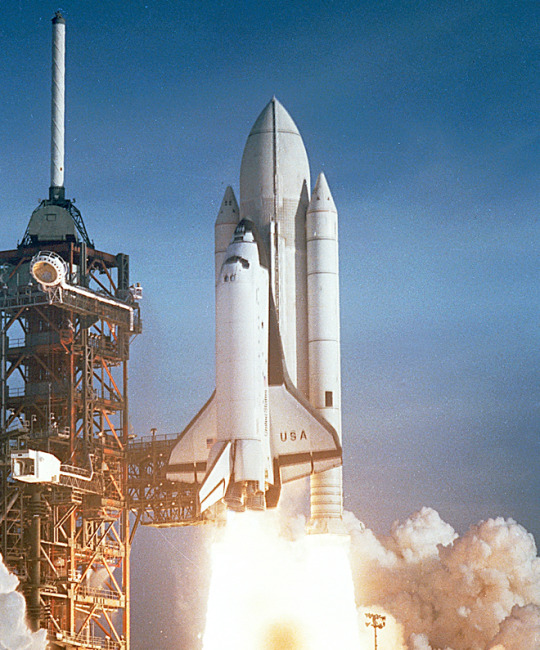
The Space Shuttle Orbiter Columbia lifts off at the start of STS-1.
The first Shuttle flight, designated STS-1, did not in fact lift off until April 12, 1981. As in the STS Flight Assignment Baseline document, OV-102 Columbia performed the OFT missions; OFT concluded, however, after only four flights. After the seven-day STS-4 mission (June 27 - July 4, 1982), President Ronald Reagan declared the Shuttle operational.
The first operational flight, also using Columbia, was STS-5 (November 11-16, 1982). The mission launched SBS-3 and Anik-C/3; because of Shuttle delays, the other SBS and Anik-C satellites planned for Shuttle launch had already reached space atop expendable rockets.
To the chagrin of many Star Trek fans, Enterprise never reached space. NASA decided that it would be less costly to convert Structural Test Article-099 into a flight-worthy Orbiter than to refit Enterprise for spaceflight after the ALT series. OV-099, christened Challenger, first reached space on mission STS-6 (April 4-9, 1983), which saw deployment of the first TDRS satellite.
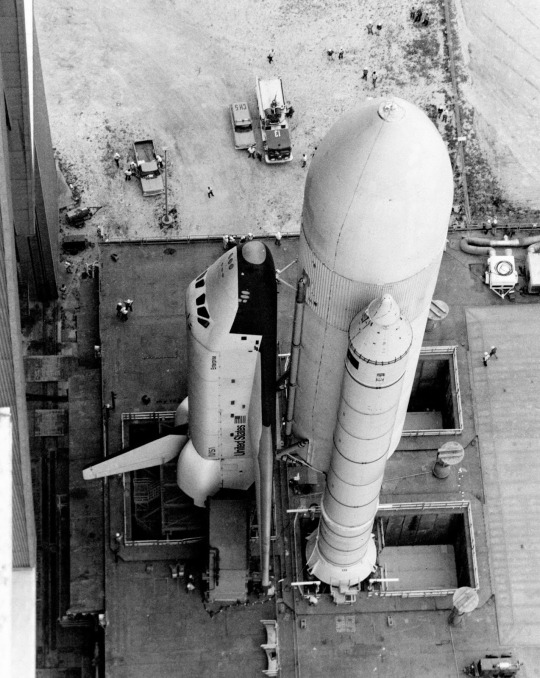
NASA put OV-101 Enterprise to work in a variety of tests and rehearsals (such as the 'fit check' shown in the image above), but did not convert it into a spaceflight-worthy Orbiter.
The voluminous Spacelab pressurized module first reached orbit on board Columbia on mission STS-9 (November 28- December 8,1983). The 10-day Spacelab 1 mission included ESA researcher Ulf Merbold and NASA scientist-astronauts Owen Garriott and Robert Parker. Garriott, selected to be an astronaut in 1965, had flown for 59 days on board the Skylab space station in 1973. Parker had been selected in 1967, but STS-9 was his first spaceflight.
The 21,500-pound LDEF reached Earth orbit on board Challenger on STS-41C, the 11th Space Shuttle mission (April 6-13, 1984). During the same mission, astronauts captured, repaired, and released the SMM satellite, which had reached orbit on 14 February 1980 and malfunctioned in January 1981. Challenger reached SMM without an OMS kit; in fact, no OMS kit ever reached space.
STS Flight Assignment Baseline document assumed that 22 Shuttle flights (six OFT and 16 operational) would occur before January 1982. In fact, the 22nd Shuttle flight did not begin until October 1985, when Challenger carried eight astronauts and the West German Spacelab D1 into space (STS-61A, October 30 - November 6, 1985). Three months later (28 January 1986), Challenger was destroyed at the start of STS-51L, the Shuttle Program's 25th mission.
In addition to seven astronauts — NASA's first in-flight fatalities — Challenger took with it TDRS-B, NASA's second TDRS satellite. The Shuttle would not fly again until September 1988 (STS-26, September 29 - October 3, 1988). On that mission, OV-103 Discovery deployed TDRS-C. The TDRS system would not include the three satellites necessary for global coverage until TDRS-D reached orbit on board Discovery on mission STS-29 (13-18 March 1989).
Following the Challenger accident, NASA abandoned — though not without some resistance — the pretense that it operated a fleet of cargo planes. The space agency had at one time aimed for 60 Shuttle flights per year; between 1988 and 2003, the Shuttle Program managed about six per year. The most flights the Shuttle fleet accomplished in a year was nine in 1985.
Shuttle delays meant that JOP, renamed Galileo, missed its early January 1982 launch window. It was eventually rescheduled for May 1986, but the Challenger accident intervened. Galileo finally left Earth orbit on 18 October 1989 following deployment from OV-104 Atlantis during STS-34 (October 18-23, 1989).
Between the time JOP/Galileo received its first funding and the Challenger explosion, NASA, the White House, and Congress had sparred over how the Jupiter spacecraft would depart Earth orbit. Eventually, they settled on the powerful liquid-propellant Centaur-G' rocket stage.
Citing new concern for safety following Challenger, NASA canceled Centaur G'. Galileo had to rely on the less-powerful IUS, which meant that it could not travel directly to Jupiter; it had instead to perform gravity-assist flybys of Venus and Earth to reach its exploration target. Galileo did not reach the Jupiter system until December 1995.
LDEF had been scheduled for retrieval in March 1985, less than a year after deployment, but flight delays and the Challenger accident postponed its return to Earth by nearly six years. On mission STS-32 (January 9-20, 1990), astronauts on board Columbia retrieved LDEF, the orbit of which had decayed to 178 n mi. LDEF remains the largest object ever retrieved in space and returned to Earth.
During reentry at the end of mission STS-107 (16 January-1 February 2003), Columbia broke apart over northeast Texas, killing its international crew of seven astronauts. This precipitated cancellation of the Space Shuttle Program by President George W. Bush, who announced his decision on 14 January 2004.
The end of the Space Shuttle Program was originally scheduled for 2010, immediately following the planned completion of the International Space Station. In the event, STS-135, the final Space Shuttle mission, took place four years ago (July 2011), three months after the 30th anniversary of STS-1. The Orbiter Atlantis lifted off on 8 July with a four-person crew — the smallest since STS-6. It docked with the International Space Station to deliver supplies and spares and landed in Florida 13 days later."
Article by David S. F. Portree: link
source, source
NASA ID: S77-5784, S77-5785, S77-5758
#STS-1#STS-2#STS-3#STS-4#STS-5#STS-6#STS-7#STS-8#STS-9#STS-10#STS-11#STS-12#STS-13#STS-14#STS-15#STS-16#STS-17#STS-18#STS-19#STS-20#STS-21#STS-22#STS-23#Space Shuttle Columbia#Columbia#OV-102#Space Shuttle Enterprise#Enterprise#OV-101#cancelled
29 notes
·
View notes
Text
"THAT CONTAINER IS LYING ABOUT ITS CONTENTS"
Matthew 7:15, “Be on your guard against false prophets; they come to you LOOKING LIKE SHEEP on the OUTSIDE, but on the INSIDE they are really like wild WOLVES.” (GNT)
My two favorite seasons are Winter and Fall! Winter, because I love Christmas, snow, carols, decorations and the like. And Fall, because I love the colors, Thanksgiving, the start of the scent of fireplaces, but most of all,…

View On WordPress
#1 Corinthians 6:19-20#1 Peter 5:8#2 Corinthians 10:13#2 Corinthians 13:5#2 Corinthians 2:11#2 Thessalonians 2:9#2 Timothy 3:5#2 Timothy 3:8#Believers#Bible Study#Change#Choice#Church#Consequences#Deception#Discernment#Encouragement#Faith#Galatians 1:7#God#Holy Spirit#James 1:13-15#Jesus Christ#Matthew 23:25-26#Matthew 7:13-14#Matthew 7:15#Quotes#Scripture#Sin#Temptation
14 notes
·
View notes